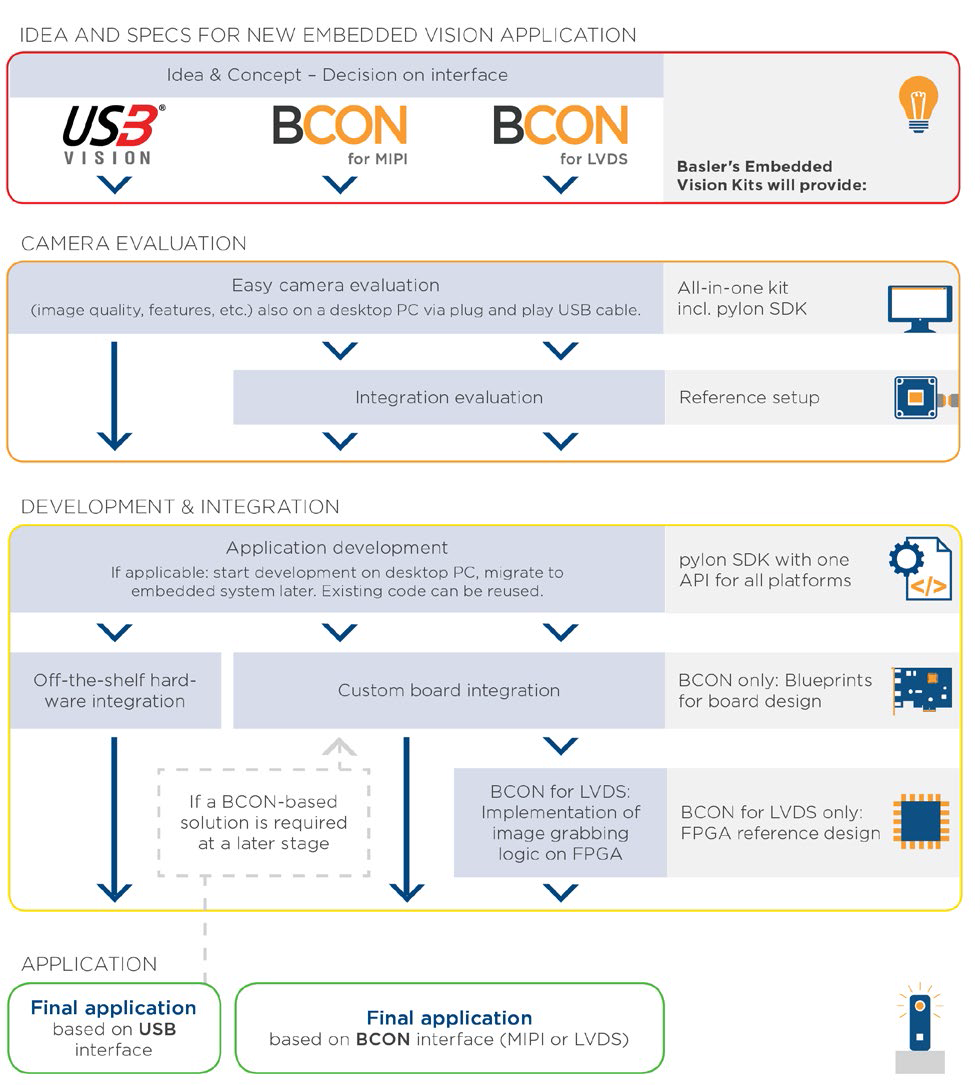If you develop vision systems, you often face what seems like an endless variety of options. Often it takes a long development period to discover which of these are most suitable – especially in the area of embedded vision. Below we will show you the options offered by the Basler Embedded Vision Kits and how you can test and evaluate possible setups faster.
Which is the right interface?
Before you can start with the design-in of your camera module, you should ask yourself which interface is best suited for your application. The answer to this varies from one application to the next and also greatly depends on the processing platform you use. If you have already selected a particular platform, a specific interface often suggests itself.
Basler’s dart board level camera module is available with a USB 3.0 interface as well as the interfaces BCON for LVDS and BCON for MIPI, which were specially developed by Basler and are optimized for embedded platforms. Basler’s proprietary BCON for MIPI interface is customized for vision systems with MIPI CSI-2. This simplifies the integration based on the MIPI CSI-2 video standard. Basler offers suitable driver packages for Qualcomm Snapdragon SoCs. This does not just result in a camera connection in minimal time but also means that the images are preprocessed directly in the ISP of the host processor. It increases the efficiency and helps streamline embedded systems without requiring you to accept compromises in the image quality.
With BCON for LVDS, cameras can be connected directly to a processor via LVDS. Many FPGAs typically offer these connections so that systems based on such a SoC are optimal for this purpose. The direct connection to the processor makes it possible to realize a lean, efficient and lower-cost system configuration. The signal transfer and processing in the FPGA, however, may entail some development costs.
As a standardized plug and play interface, the USB 3.0 interface is comparatively easier to integrate into systems. Its disadvantage is that it requires an additional (large) plug, including the corresponding electronics and signal processing. As a result, this interface is appropriate for the use of single board computers (SBC) or SoM3 modules with a USB 3.0 connection.

dart USB Evaluation Kit
See related product
Whether you decide on USB 3.0 or the BCON for LVDS or BCON for MIPI interface, with the plug-and-play dart USB Evaluation Kit – consisting of a USB 3.0 camera, USB cable, lens and the SDK (software development kit) from the pylon Camera Software Suite – you can
-- Generate an image within a minute through plug-and-play,
-- Evaluate the image quality with no effort,
-- Test the camera performance risk-free and,
-- Become familiar with the pylon SDK as the camera controller.
Even if you switch to a BCON interface later, the corresponding APIs (application program interfaces) for the camera controller are identical. This means that as the user of an embedded platform, you can apply this to develop your software and image processing while you simultaneously prepare the system setup. You can then use a dart USB 3.0 camera to develop an application at the desktop computer (which is generally significantly faster) and later port the code to the target system (with dart BCON for LVDS or dart BCON for MIPI), thanks to the unified SDK of the pylon Camera Software Suite with standard APIs.

dart BCON for LVDS Development Kit
The dart BCON for LVDS Development Kit is a reference design. In addition to the camera, processing board and accessories, it contains the required software and all drivers needed to implement a vision system. The reusable FPGA programming ranges from the image capture from the camera to the output of the image data via the pylon SDK. The sample software shows various possible applications. The helpful documentation also shows how you can access and configure the camera with a remote connection. The universally usable design of the carrier board, which is enclosed as a wiring plan, helps you customize its layout.
The development kit can thus assist you with the hardware for the complete system setup as well as the image data processing software and your user software. You can use the software code directly for your own projects, which saves you a great deal of development work. This lets you rapidly construct an appropriate vision system. The dart BCON for LVDS Development Kit is also an ideal development platform to test your application directly with the camera.

dart BCON for MIPI Development Kit
See related product
The dart BCON for MIPI Development Kit is also a reference design. It serves as a platform to test your application directly with the camera. It can also assist you with the image data processing software and your user software. The development kit consists of a dart BCON for MIPI camera module, the Qualcomm Snapdragon 820, an extensive driver package and a mezzanine board including switch plan. When you switch to a full custom design or another board, you already have the support for the hardware design. The dart BCON for MIPI Development Kit serves as a Reference on both the software and hardware sides. It can thus offer you hardware support during the entire system setup. This makes it perfectly suitable to test the image quality.




